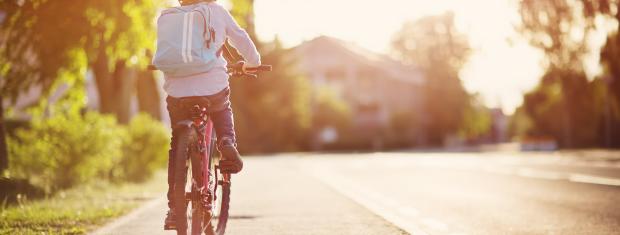
3 Safety Considerations for Children Biking to School
If your home is in close proximity to your child’s school, you may opt to allow them to walk or bike to school. Walking or biking to school are healthy ways for children to reach the recommended 60 minutes of physical activity they need each day; however, most children aren’t ready to make the journey alone until they are around 10 years old.
It is important that your child knows and understands the safety concerns that arise from traveling to school alone. Below are great talking points you can have with your child before allowing them to walk or bike to school by themselves.
1. Basic Biking Safety
It is imperative your child knows how to navigate their route to school safely before traveling alone. Work to select a safe route and practice with them a few times until they feel confident in their skills.
- Don’t ride in bad weather – instruct your child not to ride a bicycle when it’s dark, foggy or in other low-visibility conditions.
- Use crosswalks – Teach your child to only cross the road using the appropriate crosswalks and to never cross the road on an open roadway.
- Observe all traffic signals – Make sure your child understands traffic lights, stop signs, yields and crosswalks.
- Look all ways – Your child should always look before crossing the street and continue to look for vehicles.
- Stranger awareness – Make sure your child knows to say “no” if someone they don’t know offers a ride. Ideally, your child should travel to school with at least one neighbor or an older sibling.
- Limit distractions – Tell your child not to use their cell phone while riding their bicycle and to focus on the road. It is a great time to start teaching them about distracted driving.
2.Use the Right Gear
It is in your child’s best interest to use safety gear that can help them travel to/from school safely, such as:
- Bike specs – make sure the bike is the right size for your child. A bike which is too small can be gnarly, and a bike too large can be cumbersome and unwieldy.
- Helmet – make sure your child wears a helmet that fits properly.
- Bright colored clothing – bright colored, noticeable clothing is best to ensure your child is seen in traffic.
3.Basic Bike Maintenance
Walk through these basic maintenance tasks to get your child’s bike in tip-top shape for the school year:
- Check the tire pressure – make sure both tires are inflated properly before your child heads off to school. Low tires will make their ride more cumbersome and increase the likelihood of a flat tire. Check the tires for the appropriate PSI.
- Clean and oil the chain – a clean bike is a happy bike! A dirty chain containing debris will wear down more quickly and could have an effect on shifting gears and braking. Use a lubricant designed for bicycles and be sure to wipe any excess oil off after applying.
- Make sure the brakes brake – test your child’s bike brakes to ensure they safely stop the bicycle. If they have front and rear brakes, adjust the tension evenly between the two.
All children are different, so be sure to only allow your child the ability to travel to school alone once they reach the appropriate maturity and experience level.
Biking to school may be a great transition for your child and allow them to increase their time outdoors in addition to their physical activity. Following the above basic safety measures will help you feel confident in your child’s solo-biking skills. When it comes to teen driving – that’s a whole different story! Just as you taught good biking habits, you’ll have to teach good driving habits as well.


